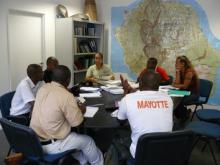Overseas issues
The French overseas territories are some of the richest areas on the planet in terms of biodiversity.1 They represent 97% of France's marine area, which is the second largest in the world, and the stakes are high to protect and sustainably manage this natural heritage. As a result, many protected natural areas have been set up by French overseas local authorities. Site managers in these areas are confronted by many difficulties.
Launch of Te Me Um
To meet the support requests of overseas managers (lien sous-rubrique gestionnaire), we initially drew up an inventory of their needs. In 2006, more than 80 people responded to our survey. The results of this survey were synthesised, which enabled the foundations of a programme corresponding to their objectives (lien sous-rubrique objectifs) to be clearly defined. In this way, we started a network for disseminating information, technical exchanges, training, and cooperation.
The network aims to:
- translate the objectives identified into local actions;
- build projects together;
- link up with other local networking initiatives such as IFRECOR (French Coral Reef Institute), and NetBIOME;
- secure the financing needed for the programme.
Governance
 This programme is based on partnerships, and requires the involvement of all the stakeholders concerned:
This programme is based on partnerships, and requires the involvement of all the stakeholders concerned:
- Managers and related stakeholders, who are the driving forces behind the programme
- The steering committee (COPIL), which validates the programme
- The local contacts, who are the local intermediaries
1Biodiversity and conservation in French overseas local authorities, O.Gargominy (Editor), IUCN France, Paris, 2003.
